
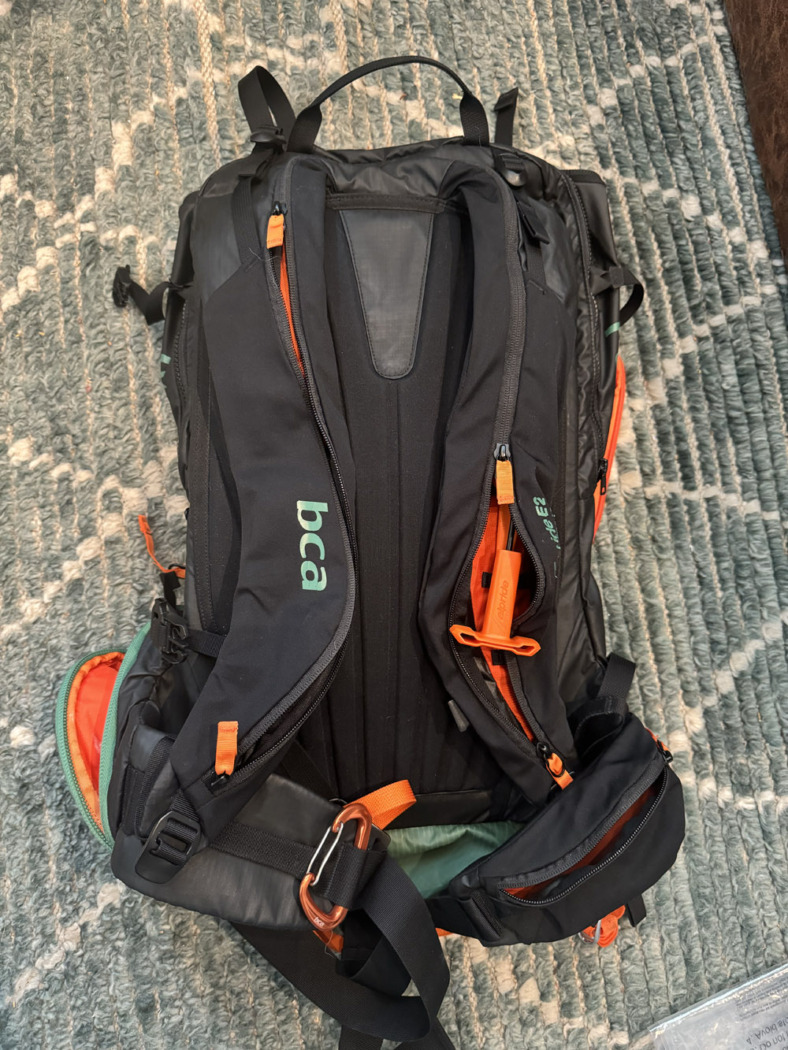
BCA Float E2 35 Review: A Durable, Reliable, And Fully Featured Sender
Electronic airbag packs are expensive, but they’re much easier to travel with than compressed air systems, plus they allow for test firing and multiple deployments off a single charge. BCA’s Float E2 35 (MSRP: $1299.95) uses Alpride’s E2 airbag system and while not new to the BCA line this season, it’s one of the best electronic airbags on the market. It sits between the more compact and agile Float E2 25, which we’ve previously reviewed here, and the Float E2 45, which will speak more to guides, hut trip heavyweights, and overnight aficionados.
In this two-season review of BCA’s Float E2 35 (testing began in early spring, 2023), we’ll touch on both the backpack itself and the Alpride E2 airbag system. Between the relatively lightweight, low-volume, and travel-friendly airbag componentry and the well-designed, rugged pack, the Float 35 is ideal for splitboarders and backcountry skiers who are tough on their gear and passport alike and need more volume for longer tours and bigger objectives.
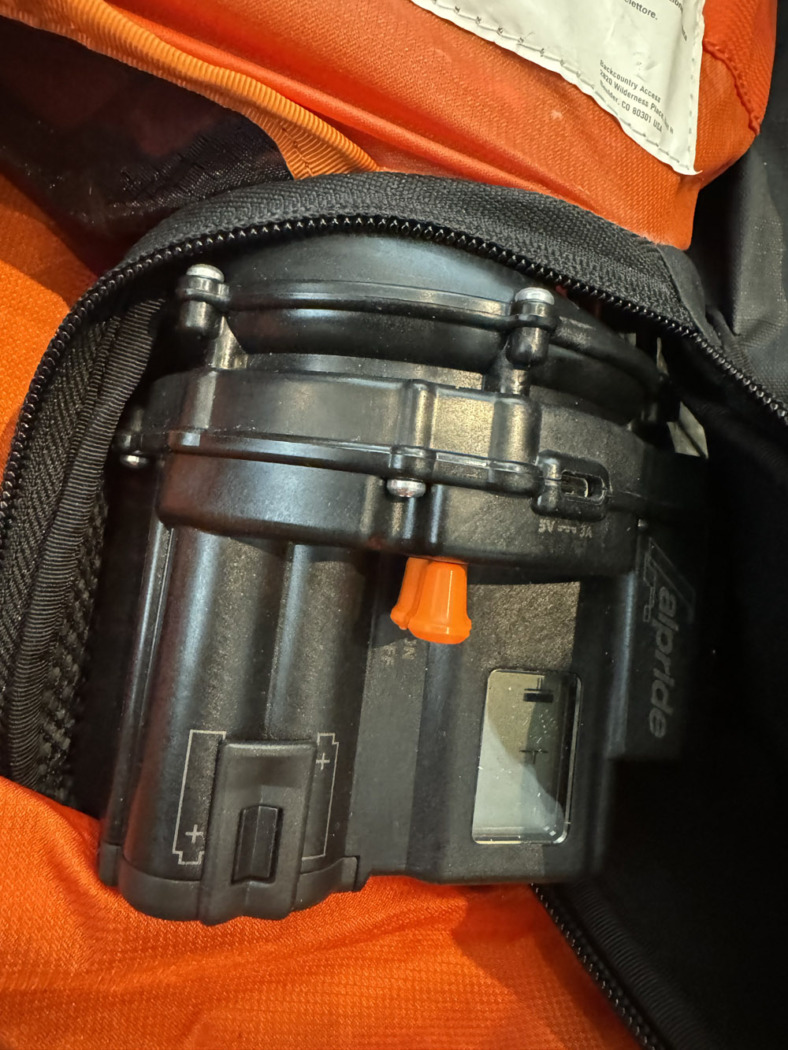
BCA E2 system’s guts.
Quick Bio: Who The Hell Are You?
Before I dive into the review, let me start by saying this is my first article for Wild Snow (longtime listener, first-time caller). Since a reviewer’s personal preferences dictate how relevant their perspective is to you, here’s a brief bio (feel free to skip this if you could care less). If you’re still here, I’m a lifelong snowboarder who started splitboarding in Colorado in the winter of 2010/2011, and soon thereafter stumbled into a career in outdoor journalism. After bouncing around the Rockies and Wasatch for the last fifteen years, I now live in Tahoe, where I split my time between touring and chairlift-accessed shredding. I am also an extreme gear nerd, direct splitboard testing for both Outside Magazine and Backcountry Magazine, and travel extensively (maybe excessively?) in pursuit of powder.
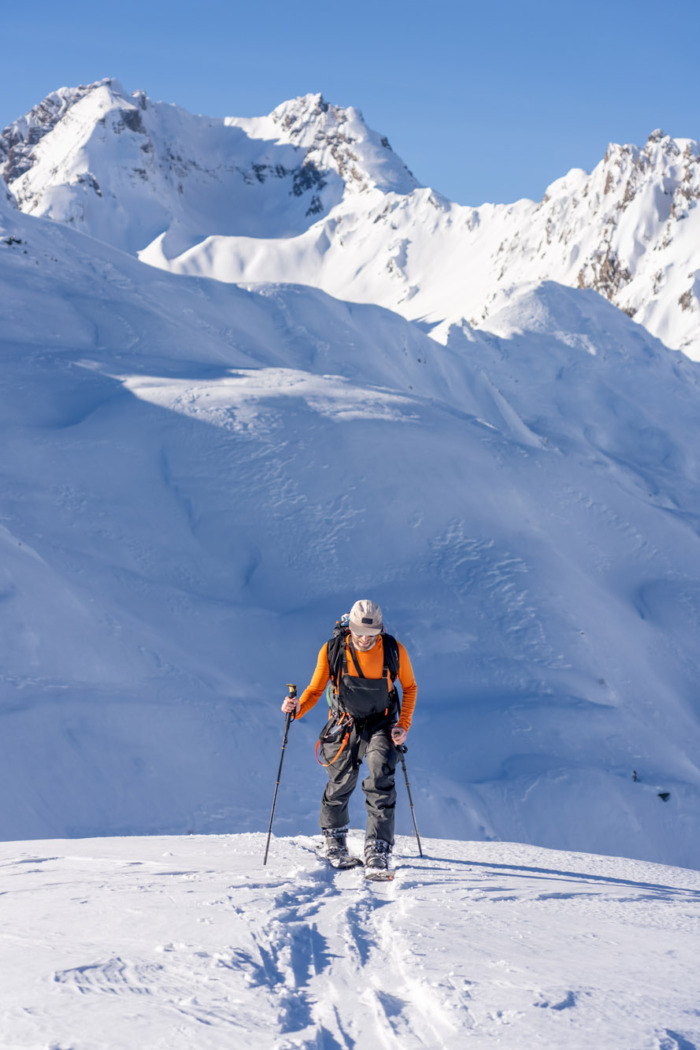
The author wearing the BCA Float 35 in Italy – Credit: Katie Botwin
All that to say, like many frequent flyers, I’ve always gravitated toward electric airbags. Over the last decade, I’ve had the privilege of testing a handful of airbags, and watching as year after year the technology has gotten better, lighter, and less bulky. The current state of electronic airbag affairs–as evidenced by the BCA Float E2 35 I applaud below–is significantly more attractive than they were five years ago. Things still aren’t perfect, mind you, but we’re getting a hell of a lot closer.
A Brief Note on The Landscape of Electronic Airbags:
Electronic airbags have been around since 2014, when Black Diamond introduced the JetForce system a decade back—these packs were revolutionary but heavy, amidst other issues. Feel free to peruse Wild Snow archives for more of a history lesson. As I mentioned above, there’s been significant evolution over the last ten years, and there are two main electronic airbag systems we recommend today: the Alpride E2 system (a recent upgrade to Alpride’s E1 system, which we first tested in 2018) and the LiTRIC system, both of which are powered by electromechanical supercapacitors (more on those below). You’ll find the E2 on bags from BCA as well as Deuter, Scott, and Osprey. The LiTRIC system, on the other hand, you’ll find on Ortovox and Arc’Teryx bags. The systems are fairly comparable, with the LiTRIC system being a touch lighter (100g), but we dive into the pros and cons of both below.
Alpride E2 System: Low-Volume And Travel-Friendly
Wild Snow’s already covered the Alpride E2 supercapacitor system quite thoroughly in this article, the second piece of a two-part review on BCA’s Float E2 25 (part one here) when it first came out in 2022. For the most part, I won’t regurgitate this largely technical information–-which is well worth reading if you like to nerd out—but instead focus more on my hands-on experience with the system in the field and comparisons to both a competitor and predecessor.
Comparing the E2 System to the E1 Predecessor
We first tested Alpride’s E1 system on the game-changing Scott Backcountry Patrol AP30 back in 2018 when the electronic system first launched. We got our hands on the 2.0 update with BCA Float E2 25 in 2022, when the update hit the market. As is typical for a product to earn a “2.0” badge, the E2 is significantly updated, improved, and slimmed down. Alpride claims the E2 system is 140g lighter than the E1 system and 40% smaller, despite adding 12 liters to the expanded airbag volume. While I didn’t remove and weigh E1 and E2 systems (Wild Snow previously reported a measured difference of 130g), I definitely noticed the difference in volume.
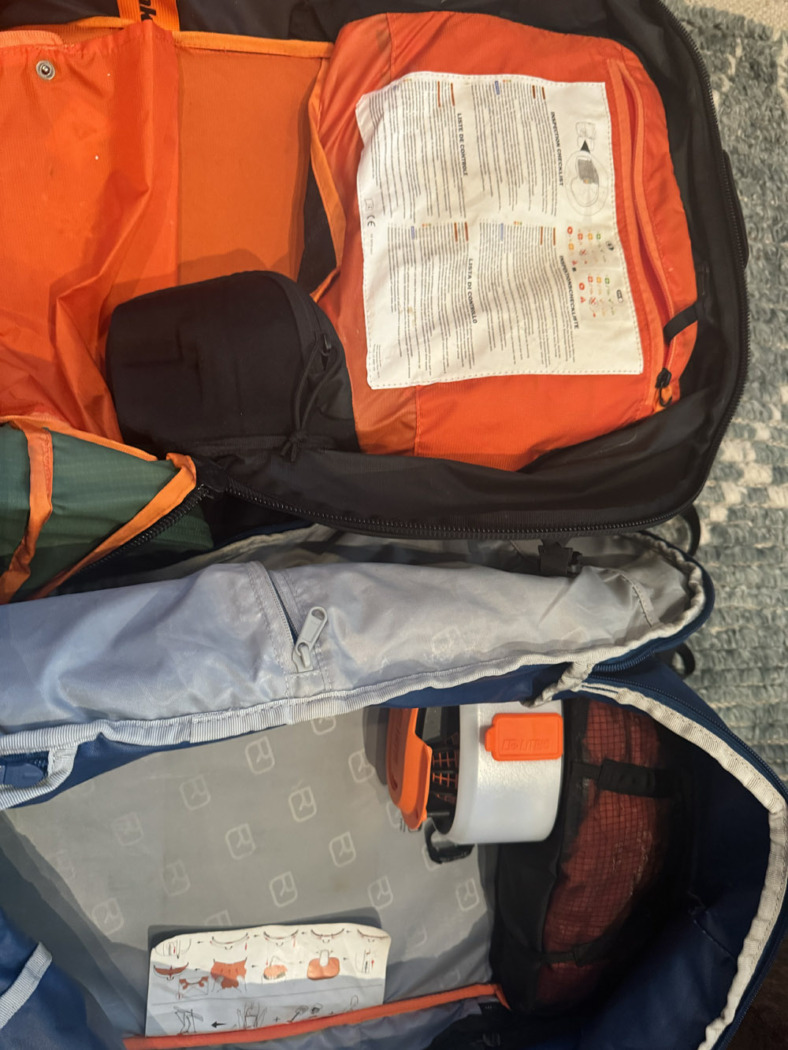
The BCA E1 system in Osprey’s older Soelden pack and the E2 in the BCA Float 35
Here, I included a photo of an older Osprey Soelden Pro 32, which uses an Alpride E1 System (the current Soelden offering from Osprey has been upgraded to the E2 system). You can see an obvious difference in size. After raiding the fridge for dairy products for comparison, the E2 is closer to the 16-ounce tub of cottage cheese, while the E1 is closer to the 32-ounce yogurt. Scientific analysis, I know. But the big difference I noticed is that when I pack up the E1 system, I have to really think about where to slot bulky gear like Nalgenes, crampons, et cetera, since the compressor dominates the bulk of the main storage space. With the E2 system (granted, the BCA has an extra three liters of volume), the compressor is much more compact, less obtrusive, and more of an afterthought while packing.
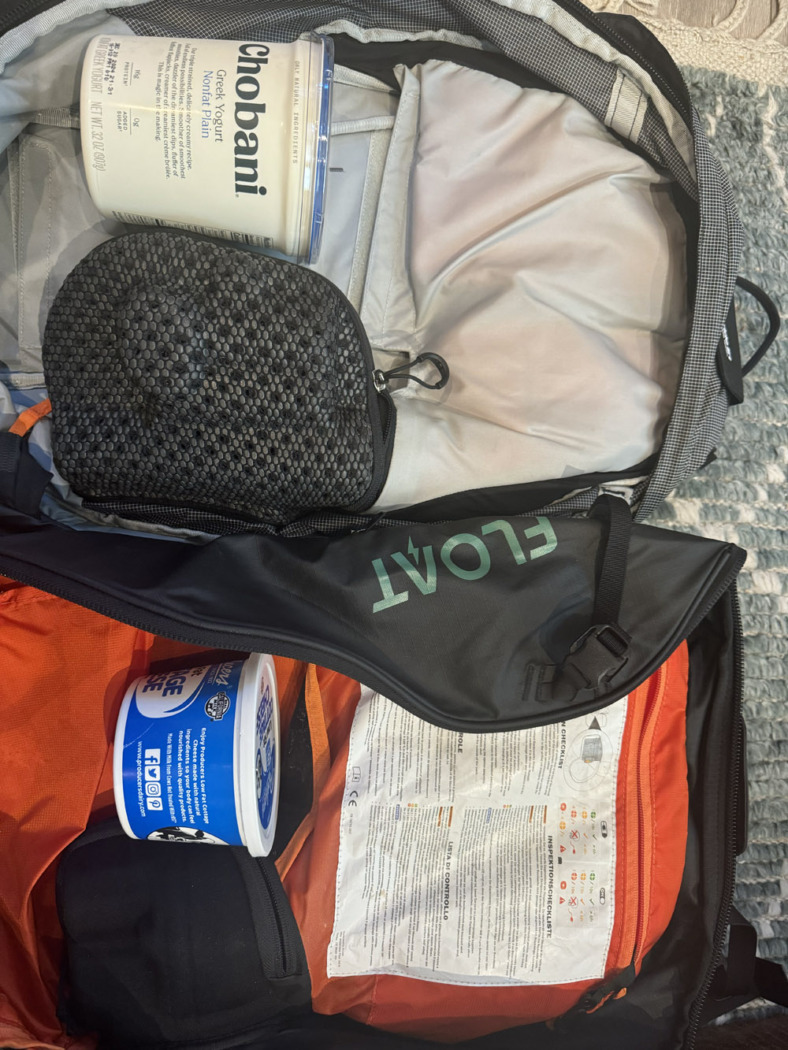
Chobani for scale.
Another upgrade of the E2 system over the E1 is a small LCD screen on the compressor that provides charging info. This is an addition, not a replacement, to standard LED indicator flashing lights which are also visible from the outside of the pack through a mesh patch. Personally, I appreciated the addition of the screen because my brain understands bars signifying battery life much better than Morse Code flashing, colorful lights. The external lights also only tell you what the overall charge level is, while the LCD screen gives you more data, telling you the charge level of both the supercapacitors themselves (the electromechanical elements that fire off the airbag upon deployment) as well as the two AA batteries that top off the supercapacitors for up to three months once you’ve charged via USB. Speaking of, the E2 charges off faster USB-C instead of the E1’s micro-USB.
One more update: more straightforward deflation. The airbag auto-deflates after three minutes, but if you’re just practicing or want to cut deflation time down, there’s a deflation knob that’s accessible through a zipper integrated into the mesh panel on the outside of the pack. Translation: you don’t need to empty or unzip your main compartment to deflate.
All told, you don’t need a PhD in supercapacitors (which I definitely do not have on my gear room wall) to glean that the Alpride E2 is a major upgrade from the E1. However, how does the system stack up against the competition? Namely, the award-winning LiTRIC system found on Ortovox and Arc’Teryx airbags.
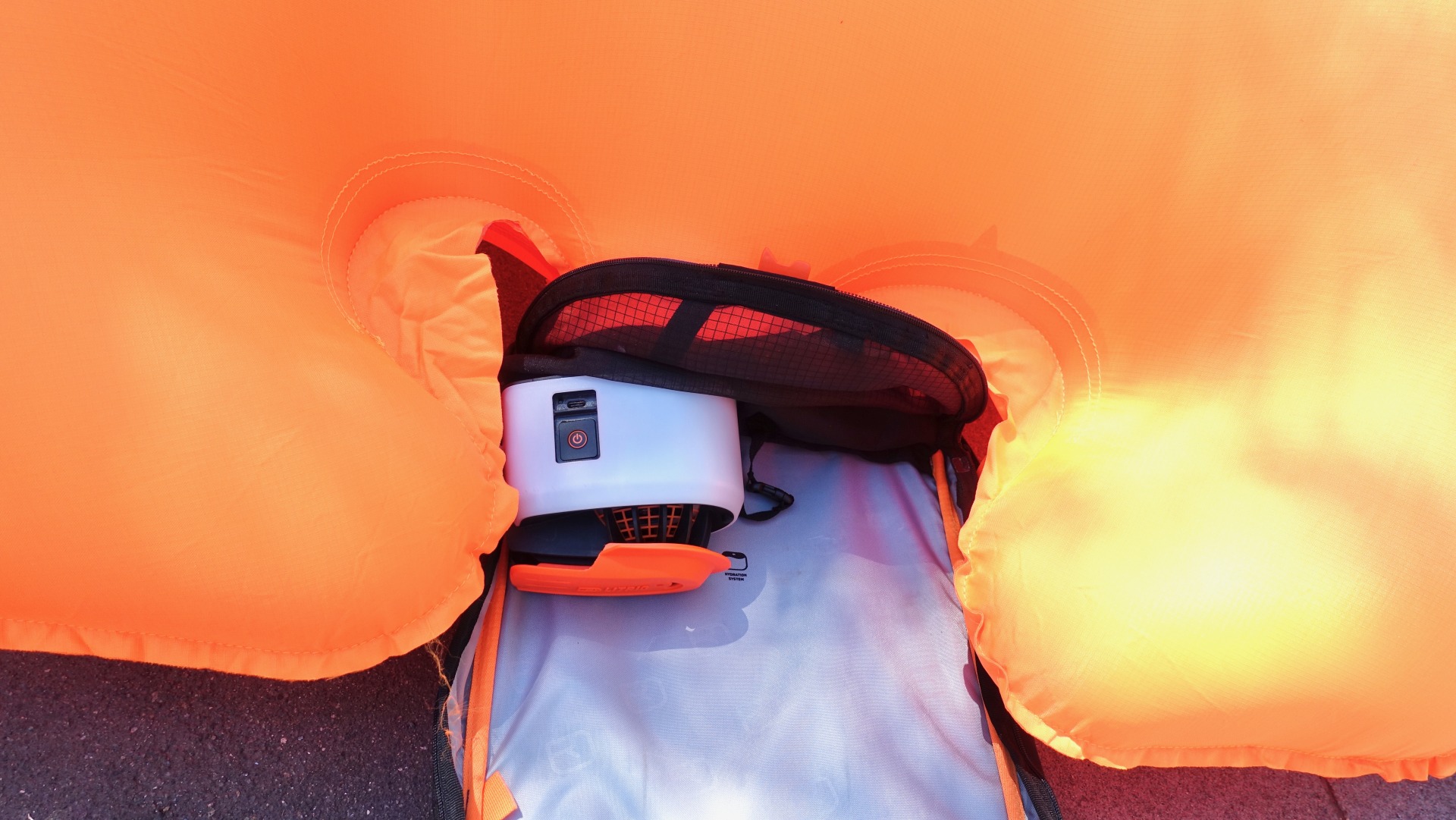
A close up view, with airbag filled, of the LiTRIC system. Here we see the uncovered power button and the USB C port. The final production models will have a removable rubber cover for this power switch/USB C port.
Comparing the Alpride E2 to its Biggest Competitor: Ortovox and Arc’Teryx’s LiTRIC System
I’m not going to dive super deep here, as I’d like to save some lung capacity to wax on the backpack itself, which, in my opinion, is a major draw for anyone considering this airbag. Additionally, as I mentioned, I’m no supercapacitor brainiac. However, it’s worth quickly comparing the Alpride E2 system to its biggest competitor: the LiTRIC.
The LiTRIC system is also based on supercapacitors, and it’s a touch lighter than the E2 (1100g compared to the E2’s 1190g, which does include the double AA batteries). I’ve been testing the Ortovox Tour 40 since this past spring, and I liked the push-button style on-off switch of the LiTRIC system more, as the E2’s pull-and-twist mechanism is a little annoying, but this is a minor gripe. Both systems seem to take up a similar amount of pack volume, although the LiTRIC airbag is more condensed and sits higher than the E2 system in the pack, which I also dug. The positioning seems to leave a little more completely unencumbered real estate for packing gear, whereas the airbag pocket on the BCA pack has noticeably less depth but takes up more surface area of the back paneling. Another minor difference.
On the other hand, the BCA pack’s E2 trigger can be zipped into the shoulder strap–a design element you won’t find in the lighter, less-featured Ortovox Tour 40. As an airtime-addicted albeit not particularly talented snowboarder who likes to jump off cliffs and occasionally eats tremendous amounts of shit, I really appreciate being able to zip away the handle. You can also switch the trigger through the other shoulder strap on the BCA, or use one side for a hydration system or a BCA Link Radio. However, the LiTRIC does allow you to twist and lock the handle so you don’t accidentally deploy the airbag, and that feature is well-designed, easy to use, and much appreciated.
The biggest difference between these two systems is arguably the way that the supercapacitors are recharged. The LiTRIC uses a built-in lithium-ion battery, while the Alpride E2 uses two AA batteries. For more info on this, Wild Snow contributor Jason Albert dissected the ins and outs of the lithium-ion battery and the LiTRIC system here.
To me, one of the main benefits of going with the E2 system is that you can top up the supercapacitors after deployment with fresh AA batteries. If you’re on a long expedition and won’t have access to an outlet for weeks on end, you can bring along extra batteries and be confident in recharging after a deployment. Here’s a note from BCA on using alkaline versus lithium-ion AA batteries, and what that means for deployments in the field:
AA BATTERIES FOR ADDITIONAL DEPLOYMENTS
In addition to the supercapacitor storage, you can install two AA batteries to allow for additional deployments in the field. The batteries also help keep the supercapacitors at full charge when not in use.
AA alkaline batteries allow for one additional deployment and is capable of keeping the system charged for up to three months of normal use. AA lithium batteries allow for three additional deployments and is capable of keeping the system charged for up to five months of normal use.
Vice versa, a benefit of the LiTRIC system is that you don’t need to bring along batteries, since the lithium-ion battery recharges the supercapacitors after deployment. I tested the Ortovox bag on a three-week trip that involved a 10-day expedition in Norway’s Arctic Circle. While I never had to deploy the pack on that trip, I had zero problems leaving it on the entire time in the kind of gnarly, sub-zero temperatures that are supposed to be troublesome for lithium-ion batteries (as evidenced by a touch of frostnip on two toes).
There are pros and cons to both of these systems, as well as subtle differences in weight, but they’re both solid. Compared to the electronic airbags of yesteryear, we’re certainly in a renaissance of avalanche safety (which hopefully continues on and on), and I reckon anyone who’s upgrading to either the LiTRIC or E2 system from a previous generation (or a compressed air airbag) is going to be stoked. My advice? Rather than focusing solely on the system itself, I recommend using pack volume, weight, features, and backpack particulars to pick your next pack. I’ll focus more on the Ortovox Tour 40 in another article, but for now, let’s dive into why I dig this BCA option.
My advice? Rather than focusing solely on the system itself, I recommend using pack volume, weight, features, and backpack particulars to pick your next pack.
More Reasons I Love The BCA Float E2 35
Durability
From day one, I had a hypothesis this pack would be extremely durable, and that hypothesis proved correct. The fabric is tough–a PU-coated Nylon 420D armor that handles everything from wet slush and snagging branches to spilled electrolyte drinks and overhead bin wrestling matches. I’ve put probably 30 days in on this pack on the field, including a weeklong hut trip in Sweden, a two-week road trip in the Alps, and a trip to Hokkaido. After significant travel, the only wear and tear I noticed is some cosmetic fading of lettering and a miniscule tear along a section of piping on the “Side Stash” zipper (more on that below).
Travel-Friendly Build
I’ve flown with this BCA pack to multiple countries and across the western United States. As I mentioned above, the durability is such that you don’t need to baby it in transit. More importantly, TSA (probably) won’t give you a hard time since it’s an electronic airbag. I had one issue during umpteen legs of travel in Washington DC. TSA did search the pack, but it was reasonably quick, I avoided a strip search, and they soon sent me on my way.
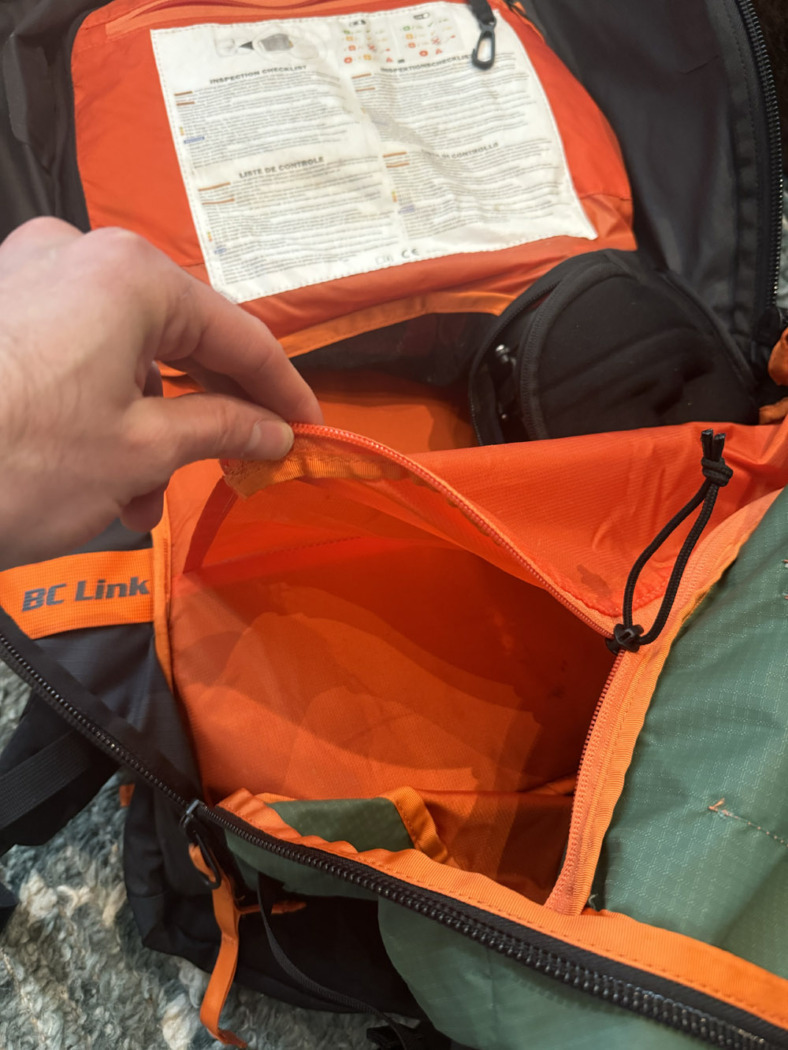
Well-Designed Pockets and Features
One of my biggest pet peeves with avy packs is when manufacturers ditch certain pockets to keep weight down. I understand the why–I just personally love to have a microfiber-lined goggle stash pocket, a hip belt pocket for snacks and chapstick and scraper… you get the picture.
The Float E2 35 doesn’t skimp. The main compartment is super spacious–-I found it solid for stashing larger items like emergency puffies, a mirrorless camera, sleeping bag liner, et cetera. The external zipper is curved, a feature I was originally concerned about durability-wise but proved rad in the field. The zipper quickly filets the main compartment open like a tuna in the Tokyo fish market, providing access to every nook and cranny.
There’s also an optional zippered divider just underneath the compressor, which helps separate dry duds from wet skins and water bottles, or sharp crampons, so on and so forth. This zone is accessed quickly via the Side Stash zip, which can be externally operated while the pack is on–a plus on time-sensitive missions. Another internal organizer pocket is located on the airbag storage pocket, which includes an integrated key clip.
Beyond the main compartment, there’s an easily accessed avy pocket demarcated by an orange zip, with separate sleeves for shovel and probe. I tested it with a few shovels, the beefiest being the BCA Dozer 2T. The blade fits, but it is a touch snug when fully loaded. There’s also a small zippered pocket inside the avy pocket, which I used for gear I’d rarely use, like my binding repair kit.
As I mentioned already, I love a microfiber-lined goggle pocket, and BCA’s is easily accessed. The hip belt pocket (singular, sigh) was spacious enough for my slimmer iPhone, a few mini Snickers bars and gummies, chapstick, and my trusty scraper.
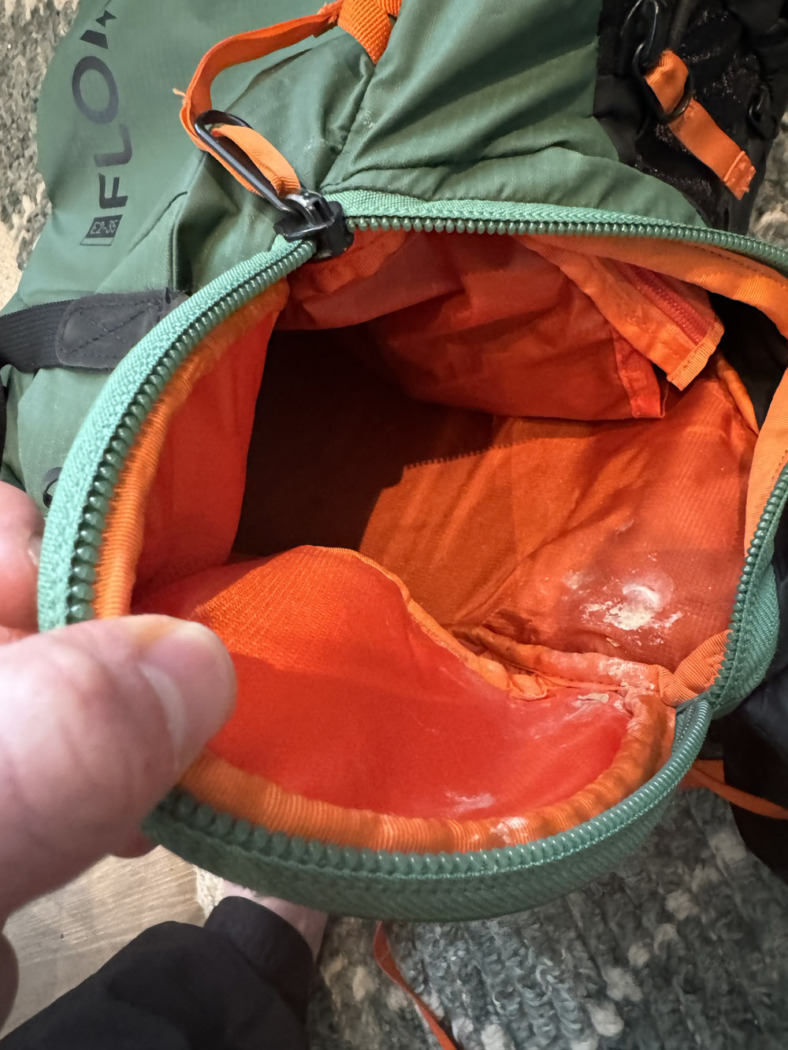
Overall Capacity & External Carry Systems
Volume, of course, is a personal game. If you’re lucky enough to have multiple avalanche packs in different volumes, good for you. But for most backcountry users, I say 35 liters is a sweet spot for a Swiss Army Knife, do-everything pack. It’s bigger than I need on most tours–32 is plenty for me, usually–but BCA outfitted the pack with A-frame ski carry straps that double as compression straps, and you can compress the pack down a touch if it’s not fully loaded. (External carry attachments also include a stashable helmet hammock, vertical board carry, diagonal ski carry, and ice axe attachments–all useful and appreciated essentials.) However, the 35-liter pack has enough hauling potential for bigger days when you’re packing sharps, colder days when you need serious layers, or even fast-and-light overnights or hut trips.
The only time I truly maxed out the pack was on a weeklong hut trip in Sweden (we pulled in group food via a sled, and didn’t need sleeping bags). I was able to fit a spare set of socks, base layers, sleeping bag liner, two Nalgenes, toiletries, and down hut booties, as well as crampons, an ice axe, harness, and a Petzl RAD system. It was maxed out, yet the padded shoulder straps and firm foam back panel ensured the weighty pack remained manageable.
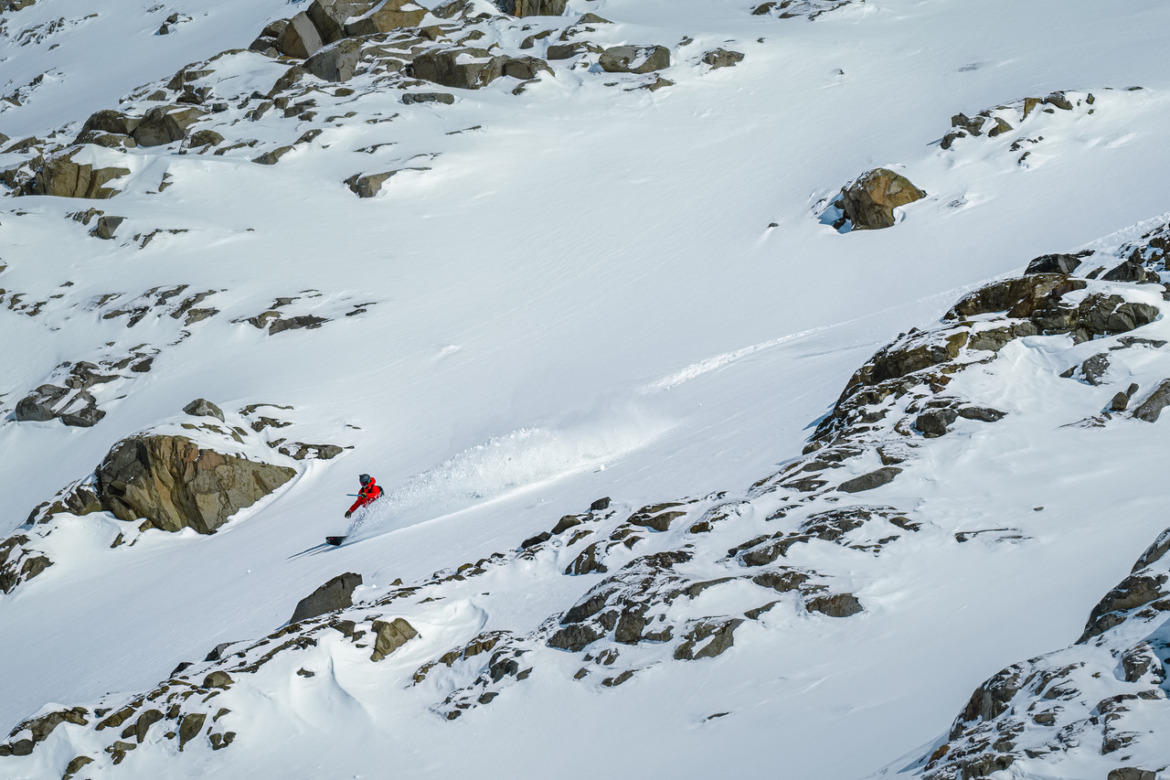
The BCA Float 35 travels abroad. Credit @matsdrouggephotography, taken in Sweden
Solid Ride Quality
I was very impressed by the downhill ride quality. I had no problem hucking myself off cliffs and pillows or riding at the edge of my ability in freeride terrain. The padded straps, hip belt harness and the stiffness of the back panel, plus the compression straps for cinchability, allow you to send it when it’s go time. Solid–no notes here.
A Few Minor Critiques
The downside of the Float E2 35’s durability, as you can probably guess, is weight. While the Alpride E2 system is fairly competitive, the pack itself is not the lightest option on the market. BCA claims the weight is 6.1 pounds, while my cheap luggage scale seemed to have the medium/large pack be closer to 5.5 pounds, but definitely sub-6. The Ortovox Tour 40, in comparison, has a claimed weight of 5.42 pounds, and my scale has it hovering right around 5 pounds, if not a hair under (although it’s missing some features like a hip pocket–more on that in a soon-to-come review).
If you’re grumbling about the lack of precise data, dear gram counter, my apologies. I’m not a fast and light guy–I’m a splitboarder who is more concerned with downhill performance than uphill speed–and I don’t own a drug dealer scale. My normal issue is overpacking for international travel, hence the luggage scale. Maybe if Wild Snow keeps re-upping on reviews, I’ll finally fulfill, as Rick Ross once waxed, my triple-beam dreams.
Drug trafficking jokes aside, I’d also love to have two hip belt pockets, but the right hip has a loop instead. Alas. Also, while there are two ice axe loops, the pack only comes with one velcro strap. You can get around this–I often rode with both an ice axe and a whippet–but it’s worth noting.
While I didn’t notice any issues with the chest strap as Albert did in his Float E2 25 review, I had the left side of the hip belt loosen a couple of times while touring. This wasn’t frequent, but it was minorly inconvenient and required re-cinching.
Lastly, I’m pretty skinny (5’9”, 155 pounds, 30-inch waist at the beginning of touring season, 29-inch waist in spring) and needed the hip belt cinched almost all the way down on the uphill for comfort and on the descent for rideability. If you’re a couple of inches skinnier than me, you may be cutting it close on a medium/large pack.
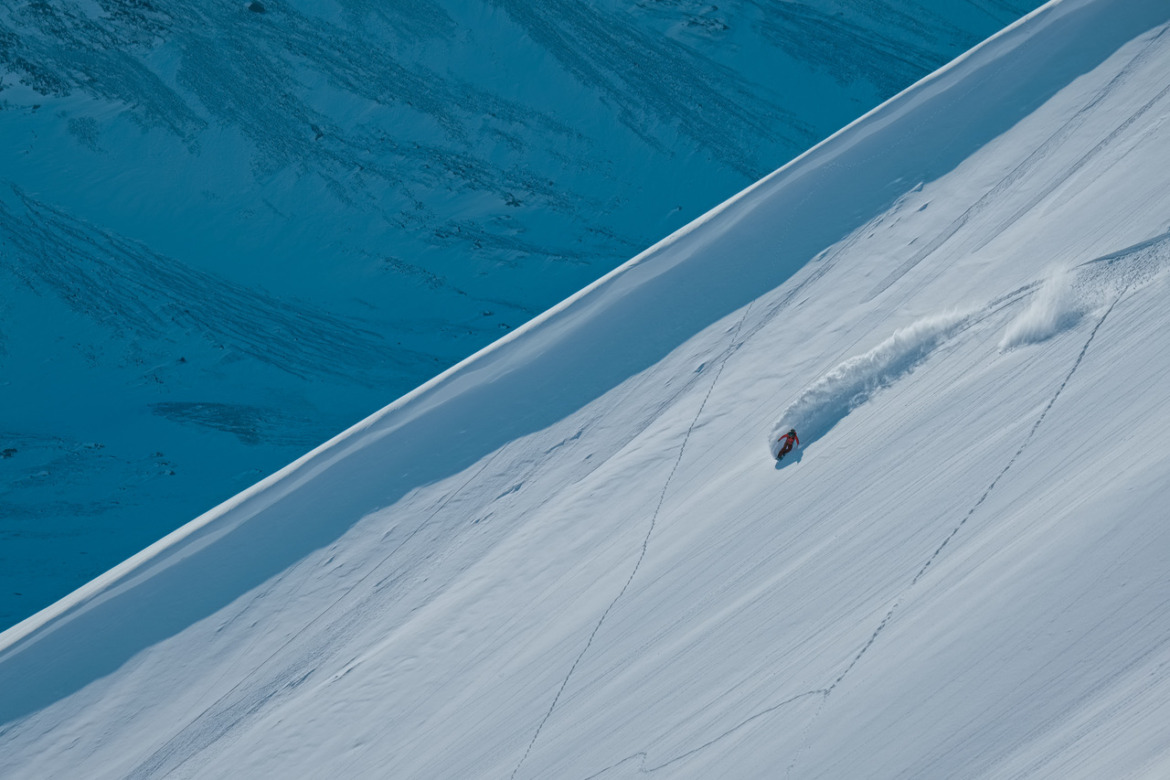
Credit @matsdrouggephotography, taken in Sweden
The Verdict: The BCA Float E2 35 Is Ready To Send For Seasons To Come
A litany of pros overwhelm a few minor cons (which we see in virtually every airbag) here. All told, the BCA Float E2 35 is a fully featured and highly durable avalanche airbag that uses one of the two leading electronic airbag systems on the market. If you’re counting grams, it’s not the lightest electronic airbag pack on the uphill, but it’s built to last, smartly designed, user-friendly, and ultra-organizable. The 35-liter capacity, combined with compression straps, makes it a sweet pick if you’re looking for one airbag that works both on average tours and bigger days alike. The battery rechargeable supercapacitor is a great pick for expedition use. Most importantly to this powder-hungry reviewer, it offers skiers and riders excellent downhill feel, fit, performance, and security.

I’m Drew Zieff. A mountain-loving, powder-chasing, ink-slinging freelance journalist and copywriter. I’ve penned stories for publications such as Outside Magazine, Backcountry Magazine, and Popular Mechanics, among others. Longtime WildSnow reader and now a contributor.

